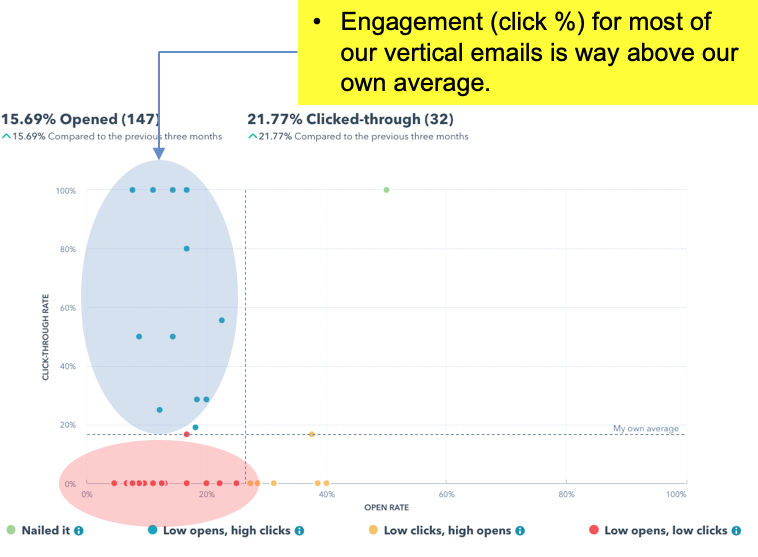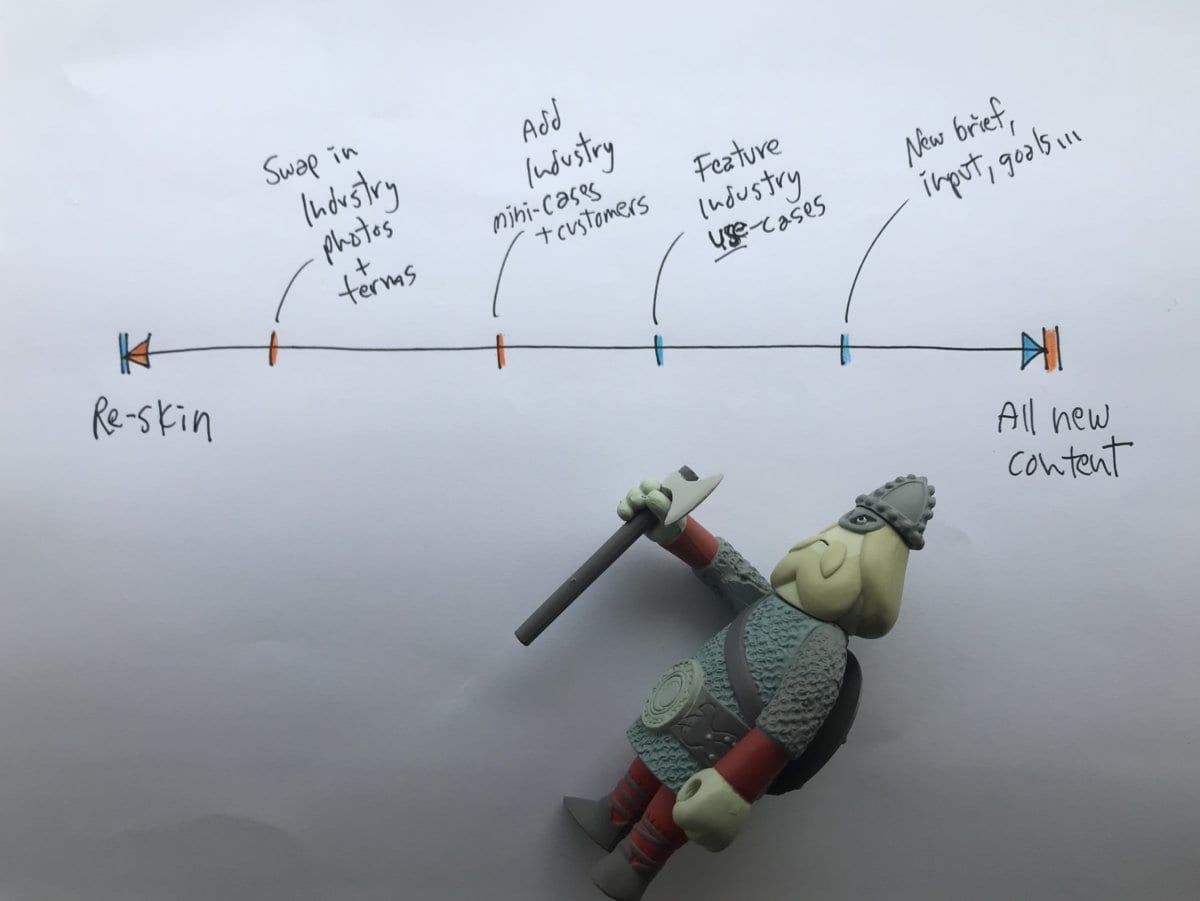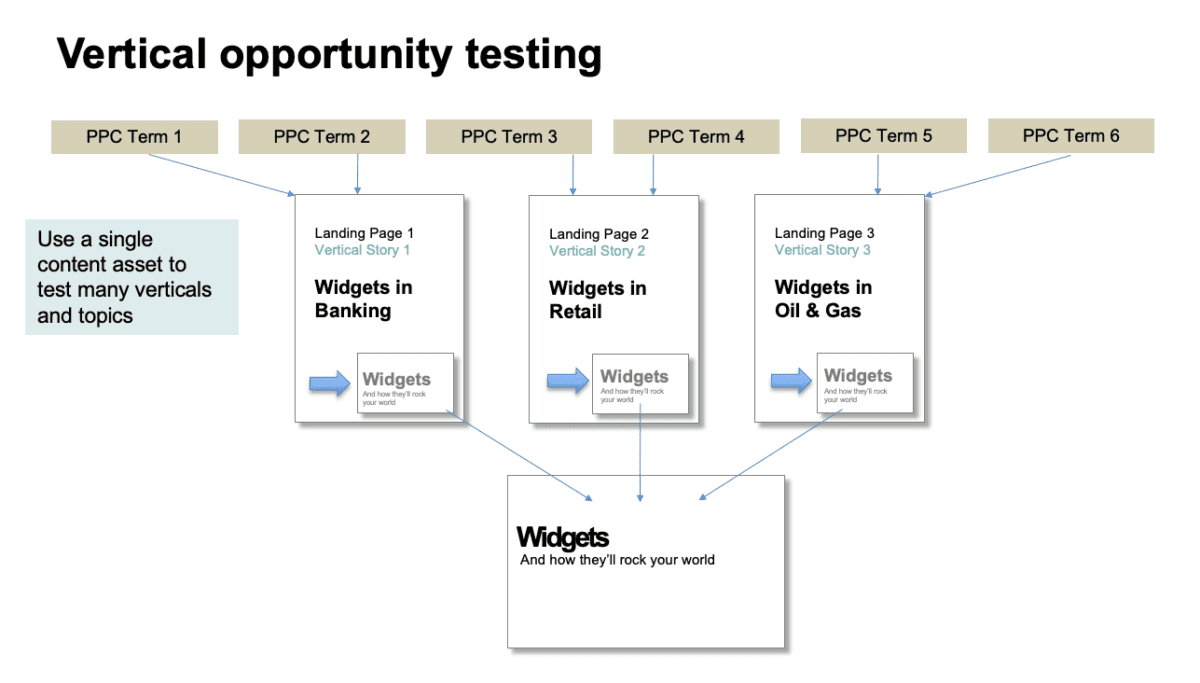If there’s one question that strikes terror in the hearts of most B2B marketers, it’s this one:
“Hey, why don’t we try some vertical content?”
I’ve seen it dozens of times (often because I was the one asking the question). Just about every B2B marketer understands the power of targeting vertical industries. But very few want to do it in earnest.
This post will explore the what, when, why and how of vertical content marketing (and vertical marketing in general) and why I think it’s underused and over-feared. My goal is simple: to help you get over yourself and give it a try (if you haven’t) or to get serious about it (if you’ve just started) or to feel great about yourself if you’re killing it (keep up the good work).
Let’s do this.
What is vertical content marketing?
Um, it’s creating or re-shaping content to address buyers in a specific vertical market.
Vertical marketing is one of the first steps towards one of the most powerful tactics in B2B marketing: segmenting your audience into chunks to you can market to them differently.
Vertical chunks may be the first real segmentation any B2B marketing team does. (The only more fundamental segmentation is probably “customer/non-customer”).
As such, it’s also the first step towards that mythical thing called Personalization (fetishized in breathless phrases like, “True one-to-one marketing”).
While personalization can be kind of hard to get your head (okay, my head) around (involving icky things like data and martech and integration), segmenting your audience by industry and targeting each with specific content is easy to understand and not that hard to do (though scaling can be a bitch, as we’ll see).
Vertical marketing is also the shallow end of the Account Based Marketing pool. Even if you’re not yet ready to dedicate resources to a few named accounts, you can still target priority industries. It’s a good place to start what my imaginary friend Pesky calls “Your ABM journey”. (Pesky has few other friends).
That’s what vertical marketing is. Now the why.
But what’s an industry?
Should be obvious, right? Some industries are clearly industries (like banking). But what about retail? That can be both a vertical industry and a discipline within another industry (the retail arm of a bank).
Sometimes so-called ‘vertical’ programs are really targeting a persona or line of business (HR, Accounting). But sometimes these lines of business kind of act like vertical markets—with their own problems and challenges and jargon.
For this piece, let’s use ‘vertical’ for mostly discrete industries (with their own SIC codes). But the same thinking can be adapted to work for any segment you want to treat separately
Why do vertical marketing?
You already know the answer in your gut even if it’s not yet reflected in your strategy:
Vertical marketing increases the resonance and credibility of your content. And content with lots of these two things out-performs content with less of them.
Say you’re a procurement professional in the supply chain industry. (Just say it, for Christ’s sake and we can get on with this). In your efforts to find a new, um, Cloud Purchase Helper Suite, you visit the websites of two likely vendors.
Vendor A, Procuriatata, has a Resource Library swollen with come-hither content sporting titles like, “The Six Essentials of Cloud Purchase Helper Suites” and “Why Cloud Purchase Helper Suites Will Help Drive Down the Cost of Yadda-Yadda-Yadda”.
In refreshing contrast, Vendor B, ProcProMax, offers stuff like, “The Role of CPHSs in Supply Chain and Logistics” and “How CPHSs help Supply Chain Procurement Professionals Procure Things In Such A Way That They Bloody well Stay Procured”.
Feel the difference?
Vertical content makes people from that industry lean forward because it sends these important signals:
- Companies like yours use this product – So you’re less likely to be a pioneer, with the arrows in his back.
- This product addresses your specific use cases – It’s used to help people do things your people do every day.
- We understand your industry – We’re insiders – We’re in your industry not just in software or whatever
- We value your industry – It’s important enough to our business to target you specifically.
- We’ve probably ironed out those early glitches – The ones you’d only find in your industry. This is not our first barbecue.
Those are some KILLER signals to send, aren’t they?
It’s hard to argue against the logic: vertical content is more likely to resonate and build credibility with buyers in that market. So it’s more likely to do the things you really need content to help you do: like engage and educate and convert.
But logic alone is not enough to convince today’s data-addicted marketers. So you’ll definitely want to test for yourself. When we’ve done so with clients, vertical content invariably out-performs generic (to the degree you can remove other variables — not so simple in this case)..
Here’s a pretty chart from a recent deck:

(Needs work on our subject lines though).
Why to avoid vertical marketing?
As compelling as they are, the reasons to do vertical marketing inevitably smack into the brick wall of “maybe next year”.
Because vertical marketing is a pain in the ass:
- If it works, every stakeholder connected to a vertical will want their own and that’s just not sustainable.
- It takes just as much time, money and effort as general content but only addresses a slice of your buyers. (Do the ROI).
- It creates the risk of ‘content clash’ – when a prospect reads a general piece, then the vertical version of it and says, “Hey! What the – ?”
- It makes your content distribution and merchandising more complex – because you have to manage versions and map them to audiences and protect against spillover and stuff like that.
Those are some significant downsides, particularly for a small, overworked marketing team that’s being asked to do way more than last year with no more budget (a.k.a. every marketing team).
When to do vertical content marketing
Whether to do vertical content is one question. When to do it is another. It might be a really good idea but not yet a priority. Here are some things to consider when deciding if the time is right:
- Your world is getting content-saturated – If there’s a ton of competition for the big, general topics in your market, it’s usually time to get granular. And vertical content is one of the obvious ways to do that.
- You’ve already done a great job on general content – If you’ve slam-dunked the core horizontal stuff already, vertical could be a great next move.
- You have vertical sales teams – They’ll love you for some dedicated support.
- Your key markets are really specialized – So generic stories just won’t cut it (see below).
- You’re getting big traction in a market – It makes sense to follow big wins and serious engagement with focused content programs to exploit it.
- You’re ready to test something significant – If you love learning and experimenting and continuous improvement, going vertical is fertile ground.
Do you really need to do vertical content?
No, you probably don’t need to.
And if you’re in a market with little or no perceived variability by industry, it may never be a priority.
If you’re selling staplers, your product is used pretty much identically in every industry. “Stapling In Banking” may not have any extra resonance to the office manager in a bank. (I’d argue you can still make a case for vertical marketing in low-variability markets—but it may not win budget from other things you could be doing—like that “Will It Staple?” video series.)
The key variable here is ‘perceived specialness’. If people in a market think that the challenges relating to your solution are unique to their industry, then you need to account for that.
If you’re marketing your staplers to the offshore oil industry, you might need to highlight the ‘spark-free stapling’ feature or promote ‘It floats!’ in the message stack. Yes, you can do that in general content. It depends how important offshore oil is to your sales forecast. I’m guessing not so much.
But if you’re marketing Process Re-Engineering software, then you’re in a highly industry-variable world. Processes in banking are completely different from processes in food service. So you may fail to get any traction at all unless you go vertical. That’s extra true when the inherent industry variability creates industry-specific competitors (whose marketing is 100% vertical)—but it applies even if not.
Kessler’s First Rule of Thermo-Verticality:
The more different the markets you sell into are (as related to your solution area), the more vertical marketing will out-perform general content.
Can’t we all learn from each other?
Do we have to spoon feed everyone? Can’t a bank learn from a retailer and a vice learn from a versa?
Of course they can. And we all do this all the time. But sending general content to a vertical industry buyer is asking them to do the work of translation: to figure out exactly how this story applies to their world.
When you go vertical, you’re doing some of that work for them. Which reduces what our friends at PathFactory call “buying friction”. And less friction means faster sales cycles.
How to do vertical marketing
K. So you’ve decided to give it a go. Where do you start? You can’t just make 19 versions of every single thing you produce (if you can…. do that).
Instead, you need to decide on two things:
- Which markets to make special content for.
- How different that content needs to be for each one.
Let’s take the second one, because we’re rebels.
A verticalization spectrum

As Asgård indicates with his axe-pointer, vertical-specific content falls somewhere on a spectrum, from superficial re-skinning (change the cover… tweak the title…) to a completely new piece made only for this specific market.
The left side of the spectrum is more scalable and re-usable but won’t have as much impact. The right side is more powerful but is slower and more expensive and less re-usable in other markets.
Where you decide to aim on the spectrum will depend on a range of factors, including strategic ones (How important is this vertical?), tactical ones (How will we reach this audience?) practical ones (How much time and money do we have?), and political ones (Who’s asking for this anyway?).
The elements of verticalization
What elements make a piece of content vertical? Any or all of these, in increasing order of depth (more or less):
- Headlines, subheads and subject lines – just add ‘…for manufacturers’!
- Images – replace bank teller with lift truck
- Statistics – from within the industry
- Quotes, experts and influencers – people from the market
- Customer references – swap in industry cases
- Product mentions – highlight the most relevant
- Use cases and applications – “…extraction” for mining
- Industry trends and issues – “GDPR” for marketing
- Industry-specific terms – “citizen” instead of “customer” for government
- Entirely vertical stories
I put the language point near the bottom—the second most profound—but maybe it’s a bit more in the shallows. Not sure. It’s important though.
If you’re taking the “versioning” approach, you just need to replace the elements on this list that are from outside the industry with ones from inside. As many as you practically can. (Leaving in a data point from banking may still be okay in a retail piece. Not ideal, but it still may serve the purpose if an industry equivalent can’t be found.)
And if you’re taking the “all new content” approach, the whole shebang will be soaked in verticality from the brief to the call-to-action. (Super-relevant, not-so-scalable).
A warning about superficiality
If all of your vertical content is at the far left end of the verticalization spectrum, you might get uplift on some key metrics, but you’re probably also leaving some extra resonance-mojo on the table.
A bit of thought about the actual story itself and how to map it to this new market will pay dividends. (You lazy bastard).
How to choose the markets to target
Deciding to try a vertical approach doesn’t mean everything you do from now on must be spun into umpteen versions for every possible market.
You want to start with one or two markets most likely to deliver a return on the effort (RoE?). to do that, throw these factors into a hat and shake:
- How big or important is this market to your business?
- How unique is the market? How much will it benefit from it’s own spin?
- What’s your product-market fit? Some markets are perfect for your offer, others, not so much.
- Do you have notable customer wins in the market? If so, you’ve got credibility to monetize.
- How fragmented is the market? Targeting something like ‘financial services’ may be false verticalizing. Banking is different from insurance.
- How is your sales team organized? Are there salespeople dedicated to markets?
- How “indulged” is the market? Are buyers used to translating benefits over into their market or do they expect special focus?
Four vertical audits to help shape your strategy
Before you launch a vertical marketing strategy, you’ll want to get the lay of the land; to gather all the data you can from a variety of sources, to shape your decisions. Four quick audits will help:
- An SEO audit – to see how the people in a given vertical market talk about their issues, what topics get the most searches, etc.
- A data audit – to see how any vertical market buyers in your own database have interacted with your content. Which stuff has resonated the most? The least? Any insight into formats or channels?
- A competitive audit – To see what your rivals are up to in a given market. Any content gaps? Any topics that warrant contesting?
- An influencer audit – To see who’s shaping the industry conversations and how.
This data is all readily available and easy to harvest. Doing these quick audits will arm you with valuable insights that will help you:
- Prioritize your industries
- Optimize your content around buyer preferences in each market
- See where you might want to experiment and explore
- Spot opportunities to out-perform competitors
- Understand the best ways to promote content in a given market
- Choose the KPIs you’ll need to measure content performance
Yes, you can make decisions like this without the input from the four audits. But… why would you?
Start small
Getting going with vertical marketing doesn’t demand tons of content from Day One. Start with blog posts or email. Add social media or paid social. Try PPC. When you start to see traction, ramp up to simple content, then big-ass content, then whole, integrated programs.
And here’s a way to build a mini-lab for vertical stories:
A cool way to test for vertical resonance
Starting to experiment with vertical marketing doesn’t mean you have to produce any vertical content at all—just a few landing pages and promotions.
One tactic we love is to build a testing machine from a series of landing pages, all linking to a single piece of general, horizontal content.
The job of each landing page is simple: to tell a vertical industry story to prospects and to build a bridge to the piece of horizontal content—by showing how that content is indeed relevant to this industry.
It looks kinda like this:

So you might buy some vertical adwords—or do social media or paid social or whatever—then send that traffic to these vertical ‘bridging’ pages (one per industry). And see how they do.
If you get a lot of uptake from an industry… go big, with real, chunky, vertical content. (No this isn’t tricking your audience: it’s simply showing them why this horizontal content is relevant to their market. Because it is.)
Distribution and merchandising vertical content
So how will this great vertical content find its audience? Like this:
- On key pages of your website – like industry pages
- In personalization programs – using IP lookup and 3rd-party data to spot a manufacturer so you can serve them up manufacturing content wherever they pop up
- Via email – if you’ve segmented your database
- In paid media – content syndication, paid social, PPC, sponsorships…
All of these can really help you zero-in on members of a specific market, so you can laser them some vertical content without spilling over into other audiences.
Vertical channels plus vertical content is a great combination.
So what have we learned today. Anyone? Anyone?
I don’t know about you but I learned that:
- Vertical content will often out-perform general content because it increases resonance and credibility.
- But it may seem like it will be a big pain in the ass, while actually narrowing your audience.
- But, if the time is right for your company, it can really pay off.
- And you can go vertical without a lot of time, money or effort, if you’re as smart about it as you are about so many other things.
- Just pick a good market or two, decide what level of customization you want and give it a go.
- Four quick audits (SEO, data, competitive and influencer) will help guide you.
- And don’t forget to pick your KPIs up-front and measure the results so you can ramp up the wins.
Got any verticalization insight to add? So add!

Enjoyed this article?
Take part in the discussion








Comments
Chris Finch Active Mind Communications May 21st, 2019
Hi Doug – This wins for my favorite blog post from May 20th, 2019.
Now you can print this comment and pin it on the bulletin board next to your homemade “Man U. Sux” patch and look at it every time you need a lift.
Seriously, this is great stuff! Thx.
Doug Kessler May 23rd, 2019
Thanks, Chris.
Duly printed and pinned.
Amanda Levine PathFactory May 22nd, 2019
Another banger. Great stuff Doug!
Doug Kessler May 23rd, 2019
Thanks, Amanda!
Gaurav Suman Solace July 8th, 2019
Great stuff. I was lost on the “why” and this article went much further and gave me the “why”, “why not” and “how”.
Doug Kessler July 8th, 2019
Thanks, Gaurav! Why not indeed.
Pradeep Maurya SSC English By Pradeep Sir July 17th, 2019
It is very nice article for readers
Trish Thorn Trish Thorn June 10th, 2020
I came here from the future – June 2020, to learn about vertical marketing (straight to the oracle, of course) and my mind has been blown. So simple, yet the potential for impact is crystal clear. Thanks Doug and Team!
Doug Kessler June 22nd, 2020
Thank you Trish!
Robert Price CertTech September 17th, 2020
I just signed up after reading this post.
Please send me more crap.
Bob
Doug Kessler September 28th, 2020
Thanks, Bob, we will!
Charles Saba SEO June 28th, 2021
A vertical marketing approach focuses strongly on the demands of a particular audience. You may maximize your commitment efforts and probably reduce the sales cycle and the cost of sales by adapting to an industry or audience.
Edulekh July 16th, 2021
Wow, this article is just awesome. It is gonna help me too much, thanks for sharing. ♥